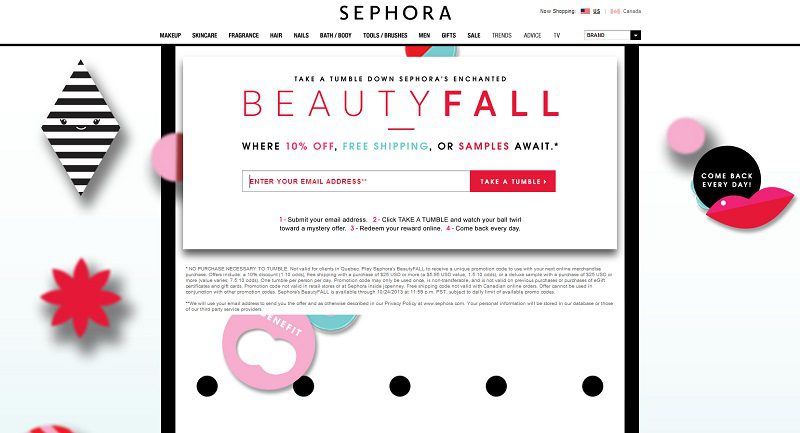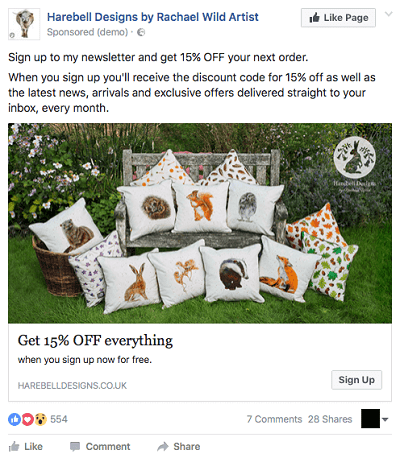

If you sell on Shopify, a mailing list is one of the first things to start working on. You need people’s email addresses to send them your Shopify newsletter with promotions, new products, and company information. It’s a major driver of engagement and sales.
So let’s look into how to set up a lead capture and actively build a Shopify mailing list.
1. Create a Signup Form or a Popup
To start capturing subscribers, you need a mailing list popup or signup form. The difference is in whether it’s static on the page or pops up triggered by a certain visitor action, e.g. exit intent to catch them before they navigate away from our site.
How to set up a mailing list on Shopify
The Shopify app lets you collect emails at checkout or via a subscription block on another page. However, if you want more flexibility, consider using a third-party like Sendinblue app to create an email signup form.
- Design — make it match your overall branding in terms of colors and copy
- Email call-to-action (CTA) — be clear and honest about the outcome (see GDPR section below). “Join our newsletter”, “Keep me in the loop”, or similar all work.
- You can ask for a phone number for SMS marketing as well.
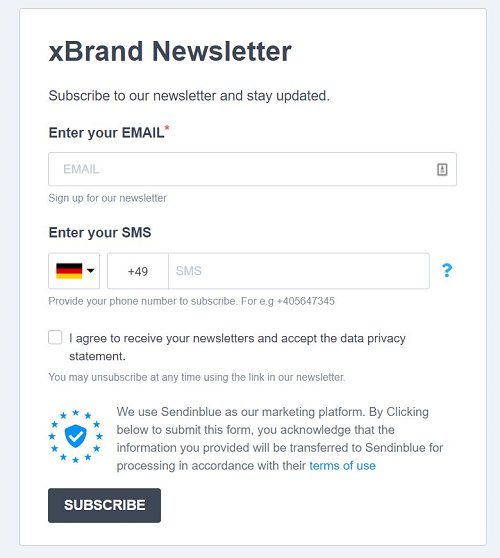

Asking for phone number on signup
Shopify mailing lists and GDPR
Under GDPR, you need to collect explicit consent from people that they want to receive marketing emails.
A GDPR-compliant form explains exactly what people are agreeing to and asks for their proactive consent. You cannot send email marketing campaigns to contacts who haven’t signed up to your mailing list themselves.
When new customers give you their email address at checkout, that doesn’t count as consent to marketing. It can only be used for transactional messages. You can add a dedicated checkbox they have to tick to sign up for your newsletter as well.
Important: Don’t set up your consent collecting forms with a preselected opt-in option. That’s against GDPR and your European customers won’t like it.
What’s more, if you let people give consent explicitly, you’ll get the ones who are actually interested, which means a more engaged audience. What’s the point of forcing people onto your Shopify mailing list if they’ll unsubscribe or mark you as spam, hurting your email deliverability and open rate?
Where to place the email signup?
A subscription form can be placed on your home page, about us page, or blog. Those are all pages potential customers visit to get to know the ecommerce business before purchasing. So it makes sense to ask them to sign up if they want more information.
Promo pages can also be suitable to capture leads who want to get news about new products first. Sendinblue’s signup forms can easily be pasted on any page of your Shopify store.
2. How to Get People to Join Your Mailing List
Getting potential customers to register is easier than a sale right away because it doesn’t ask for money. You can even start growing your Shopify mailing list before you launch your ecommerce business. A landing page with a proposition can be enough to get people interested.
Related: 6 Email Signup Form Mistakes that are Keeping People from Subscribing to Your List
To make subscribing more attractive, it’s normal to offer free value or special deals in exchange. Here are some ideas:
- A discount on the first order
- A free consultation with an expert, related to your products, e.g. a stylist, a dermatologist, a nutritionist
- A free downloadable resource, e.g. style guides, checklists, recipes, printables
3. Shopify Email List Building Best Practices
Here are a few ideas on how to build your Shopify email list faster without any legal issues.
Don’t buy email lists
Yes, there are email lists for sale, but it’s a bad business practice and won’t help you much with your ecommerce marketing. Sending unsolicited emails hardly ever results in millions of sales. Why risk being massively labeled as spam when you can work with real potential buyers who willingly sign up for your Shopify email list?
Get subscribers through your live chat
This is a neat addition to subscription forms. If you use Sendinblue’s live chat on your Shopify store, you can ask people for their email addresses there and add them from chat to your mailing list in just a click. Of course, they have to know it’s for marketing purposes when agreeing.
Share newsletter signup on social media
You can grow your Shopify email list on social media, too, not only on your website directly. The more people see what you offer, the better. Increase brand awareness and promote your newsletter in organic or paid posts on social media.
For example, you can promote new products and ask people to sign up to get alerted when the new collection drops. Or you can drive traffic to a free resource related to your product and capture customer emails to grant access.
Use double opt-in
A double opt-in means people need to confirm twice they want to be added on your subscriber list — once on the form and then by clicking on a link in a confirmation email. Just set up a reminder when the form is filled out that the subscriber needs to check their email and confirm again.
It sounds like a drag, but it’s only good mailing list building practice. It makes sure you get only engaged subscribers with valid email addresses. With an email marketing tool like Sendinblue, you can add double opt-in to your email signup forms fast and easy.
Start building your Shopify mailing list with SendinblueEasy integration, customizable signup forms, GDPR and double opt-in capabilities, 40+ email templates, segments and automation to grow your email list. |
4. Syncing the Mailing List with Your Email Marketing Tool
So how to tell if a customer is on the mailing list?
Email subscribers show up in a separate tab in your Shopify Admin -> Customers. If you’re using a third-party email marketing app like Sendinblue, contacts from the Shopify database would be automatically synced at integration.
Any new subscriber would be also automatically added in your Sendinblue CRM along with their subscription status and attributes recorded on Shopify. And if they unsubscribe, Sendinblue would update automatically again so you can be sure your mailing list is always up-to-date.
5. Managing the List
The success of email campaigns is not guaranteed when you streamline mailing list building. Contact management or list management is important, too. This includes cleanup of inactive contacts because they only increase your bounce rate and never engage with your emails.
You can also exclude specific types of email addresses that don’t look as promising potential customers — like work emails, for example. In b2c email marketing, there’s little use for emailing addresses like info@, marketing@, hello@, etc. Remove the manually from your Shopify email list as it’s probably the competition checking out your email marketing strategy.
6. Tagged and Segmented Lists
It’s important to mention that not all subscribers have to go in one mailing list. You can have them go in more specialized lists based on their preferences. Sendinblue lets you ask for preferences at signup directly and put them in the respective list automatically.
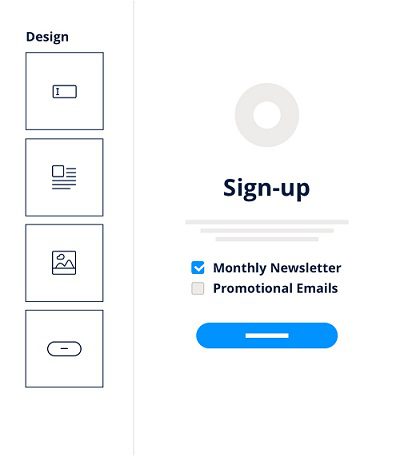

Maybe you can ask what topics they’re interested in or how often they want to receive emails. This way, you can have targeted newsletters for segmented audiences with better engagement and conversion rates.
One very basic example of this segmentation is when ecommerce fashion businesses ask subscribers if they’re interested in women’s or men’s items, and send relevant content and offers. In the example below, we see that’s exactly what NIKE’s doing.
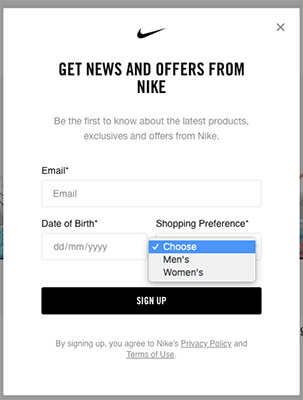

7. Sending an Email to Your Shopify Mailing List
It’s straightforward with any email tool you might be using. Choose the email list you want to target and pull up the email template you want to use. Scheduling the campaign to be sent at the ebay possible time is recommended.
Now that you have a list of subscribers, what should you send them?
The whole point of building a Shopify email list is to be able to send marketing communications to the people who are willing to receive them. Your online store’s email marketing strategy can look very differently, but usually it’’ll probably include:
- A welcome email to engage a new subscriber from the start.
- Content-rich newsletters to keep subscribers in the know about your company and industry
- Promotional campaigns — discounts, focus on specific category, or limited time offers
- New product announcements
- Sale campaigns
- Holiday marketing campaigns (Black Friday, Valentine’s Day, Mother’s Day, etc.)
- Targeted special deals by customer segment (e.g. only to people interested in a certain type of products)
- Triggered campaigns, individual to each subscriber (e.g. a birthday email, Shopify abandoned cart email, back in stock alerts)
8. Performance Tracking
Marketing emails bring up to 25% of sales for Shopify stores so it’s important to monitor that they perform well. Your long-term success depends a lot on good sender reputation, high open and click rates, and low unsubscribe rates.
It’s a good idea to check those email marketing KPIs for each campaign you send to your Shopify email list. Keep testing approaches and variants to see what works best with your audience. Maybe they like a specific type of promotion. Or maybe they love your content and open every blog update.
9. Email Campaigns to Automate
A mailing list with Shopify customers opens the door to relationship building with email. You can execute all the campaigns you planned when you have contacts willing to receive them.
First, you can automate a welcome sequence to streamline onboarding and initial engagement of new subscribers. Then, you can set up special campaigns to be triggered for a subscriber’s milestone or birthday. A drip series that nurtures interest in a new launch is another targeted campaign you can have running for particular segments of your email list.
Email Marketing Tools to Use
Shopify Email and most third-party email tools let you build and email your mailing list on Shopify. The difference is in the level of customization of the subscription forms, the GDPR compliance, the possible segmentation, and automation.
Check out our selection of the best Shopify email marketing apps.
 Deutsch
Deutsch









